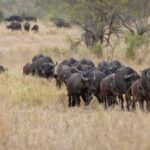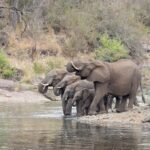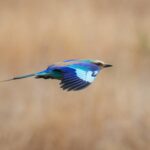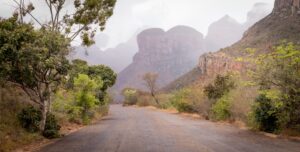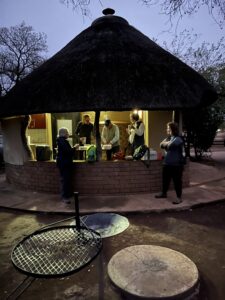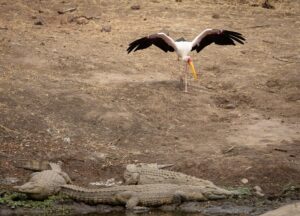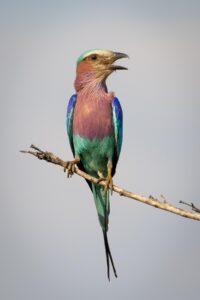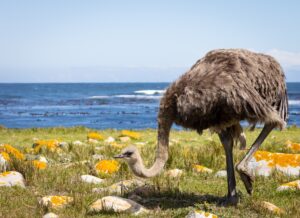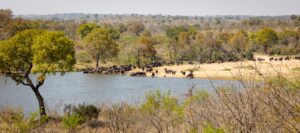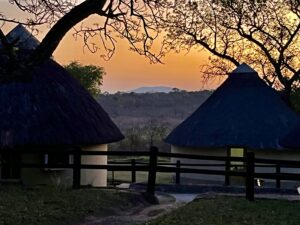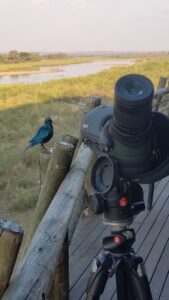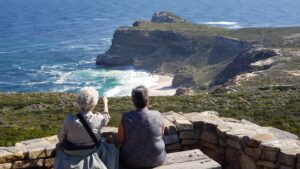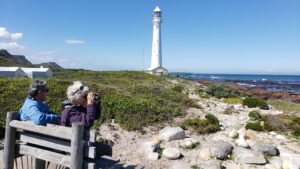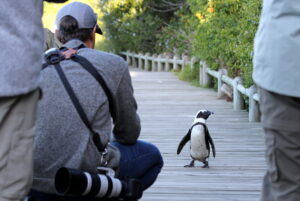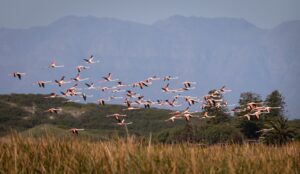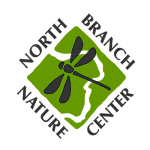South Africa's Fangs & Feathers
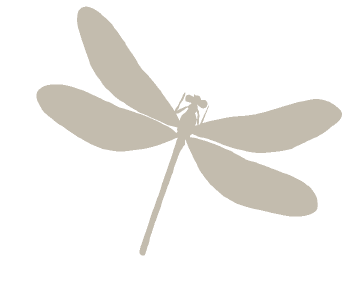
September 4-17, 2026
$5,600 per person (double accommodations)
$6,100 per person (single accommodations)
$500 deposit due upon registration
11 participants max
Alone male lion roars in the distant savanna as the African sunset illuminates a herd of cape buffalo crossing the river below you. Congregations of herons and egrets turn their heads to follow a crocodile swimming upstream towards a half-submerged pod of hippos. Looking up from your open jeep, the acacia above you is adorned with dazzling kingfishers, sunbirds, and lilac-breasted rollers. Later, you find yourself sipping morning tea at a breathtaking promontory over an endless ocean. A penguin colony bustles in the foreground, while spouting Southern right whales swim up coast beyond. In the steppes behind you, an assembly of endemic antelope and zebra stroll through fresh grass and curious spring wildflowers. Experience the birdlife and megafauna of your dreams on this great South African safari.
Additional Information
Flow of the Day: During our time in Kruger, we will convene for coffee and pastries around 5 am so that we can be ready to depart immediately at 6 am when the gates open. We will then be out in our open safari trucks for the entire morning and sometimes into the afternoon. After some rest at our lodge, we will usually head out again in the afternoon until the gates close promptly at sunset (around 6 pm). Days in the safari vehicles are long, but wildlife and bird sightings are almost constant.
In Cape Town, we will have a more relaxed breakfast and departure time in the morning, then be out at various birding destinations all day. We will have dinner either at the lodge, or at a restaurant on the way back to the lodge. There is unlikely to be any downtime on these days until after dinner.
Physical Requirements: A moderate level of fitness is required. We will not be doing anything too strenuous. During the Cape Town leg we will be doing a bit of walking and clocking up around 2-3 miles on some days. All of the walks will be on footpaths, and tracks, so underfoot conditions will vary from rocky, grassy to gravel type substrates.
Entering and exiting the safari vehicles requires climbing a ladder with high step.
Bathrooms: While in Kruger National Park, we cannot disembark the vehicles while away from lodging areas and rest areas. This means that we are often away from bathrooms for 3-4 hours at a stretch once we leave the lodge promptly at 6 AM.
Climate: September is a moderate time of the year in Southern Africa. Day time temperatures in Kruger should be high 60Fs to high 80Fs, with evenings and mornings cooling down to the low 50s. Early morning game drives in Kruger will be chilly, as we will be in open vehicles. For this reason, wear windproof shells, and layers so we can shed clothes as temperatures rise with the sun.
Cape Town has very variable weather, where we may get rain and strong wind. Day time temps are going to be 60-75F, and evenings could drop below 50F.
Health Considerations: Malaria risk is very low in Kruger at this time of the year. Taking anti-malarial medications is somewhat of a personal choice for this trip, but we don't feel it is necessary. Individuals should consult with their doctors and make their own decision.
Transportation: The land transportation will be done in 15-passenger vans with A/C. We will travel in open-top safari vehicles in Kruger N.P. This journey requires a lot of time in the vehicle, as humans are not allowed out of their cars in Kruger, and we will be on the road a couple hours each day while traveling around Cape Town.
All domestic flights are on commercial airlines. Cape Town and Johannesburg International Airport are similar in size and appearance as JFK or Newark. The Nelspruit airport is similar to Burlington.
Ash Kerby-Miller is an educator, ecologist, and Staff Naturalist at North Branch Nature Center. They studied Conservation Biology at Middlebury College, then researched the natural world professionally with the Smithsonian Tropical Research Institute in Panama and in the Green Mountains with the Vermont Center for Ecostudies.
At NBNC, Ash facilitates amphibian and owl research programs, as well as leads educational programs from insect tracking to hide tanning. Ash also led NBNC's tropical teen naturalist trip to Panama.
When not knee-deep in a river or nose-deep in a field guide, you might find them subscribing to a non-human calendar by foraging the ripest blueberries or skating the glassiest lake ice.
This trip will also be guided by two licensed South African guides. Alfie Curling grew up within Kruger National Park, and has a lifetime of intimate knowledge of the environments, birds, and wildlife of South Africa. Alfie guided NBNC's 2022 and 2024 South Africa trips. Now residing and guiding primarily in Cape Town, Alfie's trips with NBNC allow him the rare chance to return home to his beloved Kruger.
Alfie will work alongside a second veteran South African co-guide arranged by our in-country partners, Lawson's Birding and Wildlife Safaris.
Accommodation while in Kruger is all serviced South African National Parks "rondavel" chalets. The units have beds with linen and pillows, showers, toilets, and air conditioning. See photos in the itinerary sidebar for examples of these rondavels. Rooms often have a small kitchen and sitting area. There will be variation in the unit type from camp to camp.
Two meals a day will be provided, and we will either utilize the rest camps' local restaurants, which offer a range of foods from salads, vegetable, meat and poultry dishes, or we will organize our own group catering.
Fire is a big part of South African culture and we barbecue or “braai” as we call it here on a weekly basis, even at our own homes. Eating and relaxing by the fire is also a nice way to talk about our daily highlights and share in our experiences together. At Blyde River Canyon our meals will be at the lodge we utilize.
Important Note: While on safari in Kruger, wildlife watching is our #1 priority. Kruger is huge, and restaurants are few. We always intend to return to the lodge for a brunch or lunch, but our journey and sightings may often cause us to delay or skip meals in order to maximize our wildlife encounters. Please expect to miss some midday meals. Accordingly, plan to bring and eat lots of snacks in the safari vehicle. We will always count on having a full restaurant dinner each night at the lodge.
In Cape Town, we will be staying in a very nice, comfortable guesthouse overlooking the ocean, where we will have breakfast each morning. Dinners will either be at the guesthouse or at local restaurants near Simonstown.
Includes:
- Accommodations
- Breakfasts and Dinners
- Ground transport in Toyota Quantums / similar
- Open safari vehicles in Kruger
- Domestic flights within South Africa during the trip
- Entrance fees
- Bottled water in vehicles whilst travelling
- Expert naturalist and birding guide
- Expert NBNC trip leader
Excludes:
- Airfare from USA to Johannesburg and from Capetown to USA.
- Travel and medical insurance
- Lunches
- Alcohol
- Gratuities
- Items of a personal nature
Ready to go to South Africa?
Email Sean@NorthBranchNatureCenter.org to get signed up.
Payment Schedule
- A $500 deposit is required to reserve your space on the trip.
- 50% of the trip balance will be due 6 months before the departure date.
- The remaining trip balance will be due 3 months before the departure date.
All payments can be made via ACH withdrawal, or by check. Credit card payments will incur a 3% surcharge.
Cancellation Policies
We understand that incidents and emergencies arise that may force you to cancel your trip. However, NBNC invests considerable time and, in many cases, non-refundable payments to lodges and local contractors to secure our rooms and programming. NBNC aims to be as flexible as possible in our refund policy, but a full refund of your payments may not be possible after the dates indicated. All cancellations must be made via email to NBNC.
-
Cancellation more than 180 days before the trip: Full refund of all payments.
-
Cancellation 90-180 days before the trip: Refund of any payments minus the $500 deposit. If your space is filled by another traveler, we will also refund your deposit.
-
Cancellation 30-90 days before the trip: No refund guaranteed. If your space is filled by another traveler, we will provide a full refund minus the $500 deposit.
-
Cancellation less than 30 days before the trip: No refunds guaranteed.
NBNC is proud to announce that all of our trips from 2025 onward are 100% carbon-neutral. This includes each traveler's flights to and from this destination, as well as carbon emitted during the trip.
How it Works: The voluntary carbon market has come under intense scrutiny in recent years as the legitimacy and effectiveness of many carbon offsetting projects have been called into question. That's why we're proud to be working directly with the Northeast Wilderness Trust's Wild Carbon program. The carbon credits we purchase to offset our carbon emissions are used to permanently conserve forestland as wilderness. Why wilderness offsets?
- It's Permanent: Unlike most contracts in the voluntary carbon market that have a lifespan of just 10-20 years, wilderness conservation is forever.
- It's Additive: Acreage purchased and conserved through wild carbon offsets would not be protected anyway through another mechanism later.
- It's "Leakproof:" Forest protection often just shifts and concentrates timber harvest elsewhere. But wilderness conservation is different–wilderness protection here doesn't just move carbon emission over there. That's because old forests function very differently than young ones. Big trees and old soils capture and store vastly more carbon than a young forest of the same acreage. Growing an old forest is like building a natural carbon sequestration factory!
- It's More than Carbon: With wilderness protection comes additional co-benefits like biodiversity conservation, flood resilience, and habitat connectivity. This way, going carbon-neutral isn't just negating our carbon footprint, it's also actively helping conservation in other ways.
Want to learn more?:
- Read The Ecotourism Dilemma, our article on how we think about carbon emissions in the context of nature travel.
- Check out this FAQ for NBNC travelers about Northeast Wilderness Trust's Wild Carbon Program.
- To learn more about forest carbon storage, please watch Understanding Forest Carbon by climate forester Dr. Ali Kosiba.
- Please see our COVID-19 page for NBNC's full policies surrounding COVID and other illnesses.
- All participants and instructors will be required to affirm negative test results from a self-administered Covid-19 rapid antigen test taken prior to arrival on the first day of the program.
- Participants on NBNC’s Adventures Afar and multi-night overnight trips must be comfortable with the possibility that someone on the trip may contract Covid-19 (or other contagious illnesses) during the trip, even if they test negative on the first day as required. NBNC will attempt to limit exposure and isolate any such participant, which could include that participant incurring additional expenses such as hotel rooms, meals, or transportation, and missing out on group activities. However, isolation may not be possible at all times on all trips, so all participants should be aware that circumstances may require that a participant with Covid-19 continue to travel with the group.
- Participants experiencing respiratory symptoms will be required to wear a mask at all times when around other travelers.
- Failure to comply with the health and safety instructions of the trip guides will result in dismissal from the trip.
- NBNC encourages all Adventures Afar participants to be honest and transparent about their symptoms, for the sake of their health and the health of those they are traveling with.
- NBNC encourages all Adventures Afar participants to secure individual travel insurance.

Detailed Itinerary
You’ll meet with your guide at Africa Sky Guest House in the morning. We then make our way into the Drakensberg Escarpment, which stretches down the eastern side of South Africa to the Eastern Cape Province. It’s about a 6-hour drive and we make a lunch stop in the quaint town of Dullstroom or Graskop, depending on our timing.
After lunch we drive to our chosen resort at Blyde River Canyon Nature Reserve, the third largest canyon in the world. The area is wonderfully scenic, with incredible cliffs stepping down to the Blyde River, which runs along the bottom of the canyon far below. The resort is situated close to the canyon, offering private view sites and some wonderful nature walks. It’s a great place to unwind after your long flight and before the excitement of the Kruger safari begins.
This region represents a transition between the cooler grassy highlands and the hot savanna. We’ll begin seeing birds including: Swee Waxbill, White-throated Robin-Chat, Lazy Cisticola, Striped Pipit, Yellow-fronted Tinkerbird, Cape Rock-Thrush, Mocking Cliff-Chat, Alpine Swift, Collared Sunbird, Greater Double-collared Sunbird, and Brown-hooded Kingfisher.
After checking in we can relax and in the late afternoon and may head to the resort’s upper view point to see the sunset, turning the rusty cliffs a brilliant shade of orange. We’ll then have some time to freshen-up before dinner in the resort’s restaurant.
We conduct a morning bird walk while viewing the spectacular canyon formations along the Kadisi Stream, looking out for birds such as Cape Rock Thrush, Striped Pipit, Mocking Cliff Chat, Yellow-breasted Apalis, Greater Double-collared Sunbird, Mountain Wagtail, Olive Bush Shrike, Brown-hooded Kingfisher, White-throated Robin Chat and many others. There are also Chacma baboons and vervet monkeys living in the area.
After a hearty breakfast, we’ll pack and depart for the incredible Kruger National Park, entering via its Orpen Gate. We then spend the rest of the day searching for game as we make our way to Satara Rest Camp, where we will spend two nights. The mammal diversity is astounding here. You can expect to see elephant, buffalo, hippopotamus and possibly even lions, leopards or cheetah on the first afternoon! Antelope such as impala, kudu, waterbuck as well as blue wildebeest and Plains zebra can also be expected.
We will arrive in camp in the late afternoon and have some time to rest before meeting for dinner. The camps in the park are safe from dangerous game, so you will be able to wander the campgrounds and take in your wild surroundings at your leisure.
Today we spend the entire day exploring the vicinity of Satara, one of the best big cat areas in any park in Africa. We’ll embark on our first morning drive to look for leopard and lion. Excitement levels will be high as we encounter some amazing mammals.
We generally spend our time back at the camps during the warmer periods of the afternoon between 11 and 3, as this coincides with low activity periods for predators. It also provides us with an opportunity to have lunch, recharge our batteries, and enjoy the birds and smaller animals that occur within the large campground.
In the afternoon we continue our wildlife watching on an evening safari drive. In Kruger, you can really expect the unexpected: you never know what you will see next. While we have dinner in the rest camp, we’re likely to hear all sorts of nighttime sounds, such as owls, nightjars, jackals, the occasional far roars of lions, or the whoops of spotted hyaenas.
After an early morning game drive, we have breakfast back at Satara before heading south to Lower Sabie Rest Camp 50 miles away. Along the way there is a very good chance of lion, elephant and buffalo and perhaps white rhino.
On reaching Lower Sabie, we will check-in to our chalets in a beautiful, shaded rest camp situated on the southern bank of the Sabie River in the south-eastern corner of Kruger National Park. The river is the life-blood of the area, especially during the dry season, when animals tend to congregate along the river’s edge. In addition to the riverine habitat, the Basalt Plains add to the mix of habitats and provide important grazing habitat for many ungulates.
The combination of perennial water and diverse habitat is why the Lower Sabie region provides some of the most productive game viewing in the park. Time can be spent on the large wooden deck outside the restaurant overlooking the river, enjoying numerous pods of hippopotamus and Nile crocodiles. Waterbirds are diverse, and you will see different storks, herons, egrets, ducks, geese, and hopefully the sought-after White-crowned Lapwing.
Sunset Dam is just a few minutes drive from the camp, and provides a haven for hippopotamus, Nile crocodile and water birds. It is a great place to set up for an extended photography session during the day. Two nights in the area will give us ample time to explore the area.
Our morning game drive is bound to deliver something exciting, and once again we will focus on locating predators like lion, leopard, cheetah and African hunting dog. We stop along the way for anything that interests the group, such as small predators like the various species of mongooses, black-backed jackals, and caracal.
Snakes seen on our drives may include African rock python, black mamba, snouted cobra and puff-adder. Exiting the vehicle at unauthorized sites is not permitted in the park, so we will be viewing much of the wildlife (snakes included!) from the comfort and safety of our safari vehicle.
The drive along the Sabi River is beautiful, and African elephant are commonly seen along its banks. The large trees often provide great views of different eagle and vulture species, and it is also a good area for the elusive leopard!
Midday is spent around the rest camp. Spend the afternoon strolling around birding, or photographing and observing the interaction of large game in the riverbed below.
During the afternoon drive we’ll search again for large predators, which remains the primary objective for the duration of our Kruger leg of the tour. We are sometimes lucky enough to come across a fresh kill, with lion and dozens of vultures in attendance.
After our morning drive and breakfast, we head to our final rest camp for the Kruger leg of our tour. Berg-en-Dal Rest Camp is situated in the southwest corner of the park, and is dominated by broad-leaf woodland and large granite mountains that tower over the surrounding plains. Game viewing in this region is variable. In the spring it is often the first part of the region to receive rain, resulting in the first green flush of sprouting grasses.
Grazers such as Burchell’s zebra, blue wildebeest and buffalo move into the area, and the area sometimes produces rarer antelope species such as tsessebe, sable and Lichtenstein’s hartebeest.
There’s a fair chance of seeing African wild dog here. A known pack frequents the area from time to time, hunting the abundant Impala in the area. An encounter with these wide-ranging predators would be an incredible, once-in-a-lifetime sighting! This area also produces good sightings of leopard, lion, and rhino.
The birding is different than other areas of the park. Target species will include Bushveld Pipit, Retz’s and White-crested Helmet-Shrikes, Dark Chanting Goshawk, African Cuckoo Hawk, Lizard Buzzard, Southern-banded Snake Eagle, Bennett’s Woodpecker, Yellow-throated Longclaw, Yellow-throated Petronia, Pale Flycatcher, Croaking and Lazy Cisticolas and Scarlet-chested Sunbird. We should arrive in the early afternoon. After checking in, we’ll head out on an afternoon game drive before freshening up for dinner.
We depart Kruger after an early morning drive and quick breakfast, then head for Nelspruit, where we take an easy, direct flight to Cape Town. We arrive in Cape Town in the late afternoon, then to Simonstown on the eastern seaboard of the Cape Peninsula, which will be our base for the next few days. Simonstown is well-situated for a series of day tours based from Whale View Guesthouse or similar lodges a stone’s throw away from False Bay. Southern Right, Bryde’s and Humpback whales are regularly seen from the guesthouse.
This afternoon, we will take a scenic drive into Simonstown, stopping along the way at various viewpoints overlooking the Atlantic Ocean from where we would look for whales and dolphins. We will also see our first endemic birds here, including Cape Sugarbirds, Orange-breasted and Southern Double-collared Sunbird, Cape Bulbul, Cape Siskin, and Karoo Prinia.
The views of the rugged, steep coastline are exceptional. The native “fynbos” which grows on the mountains and throughout this province is one of the most diverse floral biomes in the world, and characterized by a high diversity of proteas, ericas and flowering bulbs. We’ll finish the day with a nice dinner at our guesthouse or at a local Simonstown restaurant.
Overnight in Cape Town: Whale View Manor (Simon's Town)
The order of the next two days is governed by Cape Town’s unpredictable weather. Your guide will determine which locations are visited on which day, and will keep the program flexible. You can expect to the visit the following locations during your time here: The Cape of Good Hope section of Table Mountain National Park, Kirstenbosch National Botanical Gardens, Strandfontein Birding Area, Kommetjie, and the Boulders/Stony Point Penguin Colony.
Today, however, we aim to explore the Cape Peninsula and will travel to the coastal town of Kommetjie after breakfast. We’ll walk along a coastal pathway to Slangkop Lighthouse where we will see a good number of seabird species including Crowned, Cape, and White-breasted Cormorant, Kelp and Hartlaub’s Gull, Greater-crested Tern, Grey Heron, Sacred and Glossy Ibis, and possibly Cape Gannet offshore. The surrounding native shrub thickets are also home to range of endemic species such as the Southern, Double-collared, and Malachite Sunbird, Bokmakierie (a stunning shrike), Cape Robin Chat, Southern Boubou, Cape Grassbird, Karoo Prinia and Grey-backed Cisticola.
We then drive along the west coast of the Cape Peninsula towards the Cape of Good Hope (aka “Cape Point” or “The Cape of Storms”), which is the southern part of the Cape Peninsula lying within Table Mountain National Park. As we travel along the coast we will stop to watch birds and whales. At the Cape of Good Hope we will be searching for an endemic antelope species called the bontebok, which almost became extinct in the early 1800s. These striking, tan-and-white grazers can be found wandering the coastal plains of the reserve.
Cape eland, the largest of the world’s antelope species is another mammal we hope to see on this day. With some luck we might also encounter a small herd of Cape mountain zebra.
We usually take a walk or a cable car ride to the lighthouse at Cape Point at the tip of the Cape. Contrary to popular belief, this is not where the Atlantic and Indian Oceans meet, but where the Agulhas and Benguela currents are said to converge. The views from this point are incredible, and full of seabirds. White-necked Raven, Rock Kestrel, Peregrine Falcons, and the endemic Cape Siskin are all possibilities here. If the weather is warm, we will most likely see reptiles such as Southern Agama and Black Girdled Lizard.
After our time here, we drive back through the reserve and have a good chance of encountering chacma baboons. These baboons are larger and with a shaggier coat than the ones you will see in Kruger, despite being the same species. They are also unique in having adapted to forage in the inter-tidal zone.
We then head to Boulders Penguin Colony, one of only two mainland-breeding colonies for the endangered African Penguin. The other colonies are situated offshore on islands around the South African coastline. The late afternoon is usually the best time to observe the penguins as they return from sea in an afternoon light ideal for photography. You can also expect to see rock hyrax between the bushes at Boulders as we stroll around the walkways. We then head back to the guesthouse have dinner and prepare for the next day.
After breakfast we drive to the Kirstenbosch National Botanical Gardens on the eastern slopes of Table Mountain. This magnificent 800-hectare botanical gardens which streches into the edges of Table Mountain National Park is a haven for plants and birds. We spend our time walking through the area looking at the flora and special birds like the Orange-breasted Sunbird and Cape Sugarbird, both endemic to the fynbos biome. It is a great place to photograph these nectivorous species as they feed in richly colored flowering proteas which adorn the slopes.
We sometimes see small grey mongoose and four-striped field mouse as we meander along. Kirstenbosch is also good for raptors and we keep an eye open for the scarce Rufous-chested Sparrowhawk and African Goshawk that live here. Other target species hard to find elsewhere in the Cape include: Forest Canary and the elusive Lemon Dove (reliable here over the past few years). Malachite and Amethyst Sunbird, Cape Spurfowl, African Swee Waxbill, Olive Woodpecker, Cape Batis, and African, Paradise, and Dusky Flycatchers are other target birds on this morning.
From Kirstenbosch we will make our way to the Strandfontein Birding Area or sewage works as it is locally referred to as, is situated on the Cape Flats in the bight of False Bay. You will be impressed by the numbers and diversity of ducks, geese, and other waterbirds that live and visit here. You should see hundreds of Greater Flamingos and possibly Lesser Flamingoes too. Great White Pelicans are regular along with various Old World warblers and other passerines. Strandfonetin is also one of the better places to see the endemic Cape grysbok, an diminutive browsing antelope whuch resides in the thickets between the pans and is largely restricted to the fynbos biome. Small mammals include Water and Cape Grey Mongoose and other target birds include Maccoa Duck, Hottentot Teal and African Marsh Harrier. We then depart for a dinner in Simonstown after having had a day of good exercise and a wonderful time in nature.
Depending on international departure flight times, we may conduct another activity today. If your flights were in the morning, we would transfer you to the airport directly after breakfast. For midday flights, we arrange a short excursion to the popular Cape Town waterfront area for an opportunity to check out some excellent food courts, sea lions in the harbor, beautiful views of the city, and street performers.
After a final bag check, we take the drive to Cape Town International Airport for you to check-in for your homebound flights. International flights may require flying from Cape Town to Johannesburg to catch a flight over the ocean.
Flight departing South Africa on 9/16 will arrive in USA on 9/17.

